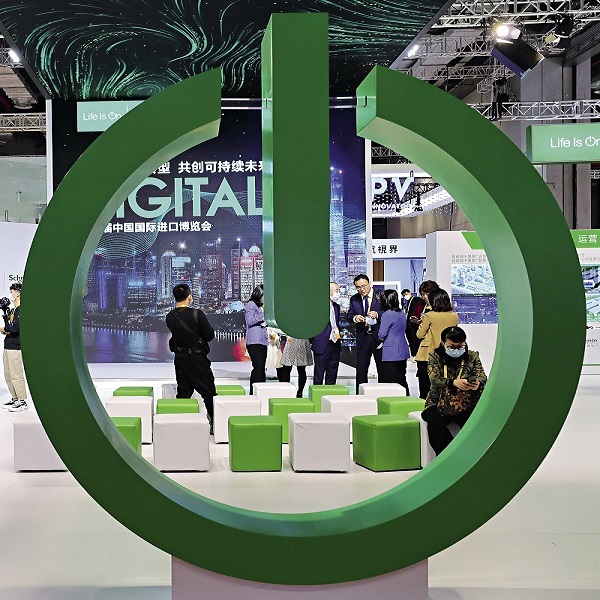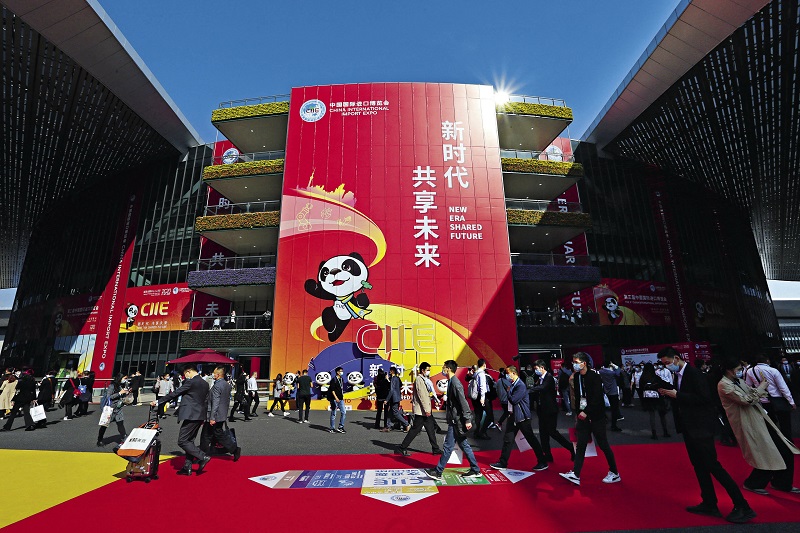DESPITE the difficult times in which the world finds itself currently, the third China International Import Expo (CIIE), held in early November in Shanghai, was a great success. The total exhibition area was expanded by close to 30,000 square meters compared with the second CIIE and a special area was set up for exhibits of public health and epidemic prevention. More new products and services also chose the event to make their global debut.
Chinese Proposals
On the night of November 4, Chinese President Xi Jinping addressed the opening ceremony of the third CIIE via video link. It was the third time Xi had shared Chinese proposals with the world on the occasion of CIIE.
Xi called on all countries to commit to opening up that features shared benefits, shared responsibilities, and shared governance. “China will stay committed to openness, cooperation, and unity for win-win results. We will steadfastly expand all-round opening up. Our aim is to turn the China market into a market for the world, a market shared by all, and a market accessible to all. This way, we will be able to bring more positive energy to the global community,” said Xi.
The keynote speeches Xi made at the last three CIIEs showed China’s confidence and willingness to take on responsibilities, as the country further integrates its development with the rest of the world in the new era.
In the face of profound changes in international situations, the question that remains in people’s minds is, “where is the globalization that used to propel world economic development headed for?” “Countries need to work together to make economic globalization more open, inclusive, and balanced for the benefits of all,” Xi pointed out the direction in his keynote speech. In the face of anti-globalization sentiments, Xi has been advocating the same view: economic globalization is an irreversible trend, and countries should face up to its “double-edged-sword” features and guide economic globalization to a path that benefits every country and every nation.
The world is undergoing tremendous changes and faces prominent problems of governance deficit, trust deficit, peace deficit, and development deficit. “We need to promote development through opening-up and deepen exchanges and cooperation among us. We need to ‘join hands’ with each other instead of ‘letting go’ of each other’s hands. We need to ‘tear down walls,’ not to ‘erect walls.’ We need to stand firm against protectionism and unilateralism,” Xi told the second CIIE.
Openness, cooperation, joining hands, and tearing down walls – these are what Xi has been calling for at the CIIEs. The principles point out a definite direction in a dark time of the world economy.

France-based company Schneider Electric sees its sealed deals at the third CIIE increase by more than 50 percent from the last CIIE.
Chinese Achievements
“COVID-19 has put all countries through a tough test. In the case of China, our people have exerted extraordinary efforts and made major strategic gains in controlling the coronavirus,” said Xi when addressing the third CIIE, showing confidence in hosting an international event during a time of an epidemic.
The third CIIE took place thanks to China’s success in bringing the epidemic under control. Putting people and life first, China has put in place a strong defense line against the virus at home. This gave an assurance to attendees that they were safe.
Epidemic prevention measures were meticulous and draconian. All those entering the Shanghai National Exhibition and Convention Center, the host venue, should have tested negative for COVID-19 during the last seven days. Only when the test result was verified in the organizer’s database, could the participants be allowed in.
Inside the venue, a special disinfection team made up of 400 members sanitized elevators, bathrooms, and doorknobs among other frequently used public spaces multiple times each day.
Efficient security checks would ensure that when an attendee passed through, a device checked everything from their body temperature to COVID-19 test result.
Chinese Platform
Inside the exhibition venue were Fortune Global 500 companies, time-honored brands from developed countries, as well as small businesses from the least developed economies. The event embraced diversity and connected businesses across the world, big or small, for shared benefits.
Statistics released by the organizer showed that the third CIIE showcased 411 new products, technologies, and services. Much of the exhibitors’ attention was given to green booth design and technology and environmental integration.
There were six exhibition areas at the third CIIE, each of which had distinctive features. The food and agricultural product area attracted 1,264 exhibitors from 93 countries, the largest number of all exhibition areas. The top seven auto makers in the world all presented their latest technologies and ideas in the automobile area. More than 90 percent of the area was taken up by Fortune Global 500 companies and leading businesses in the auto sector. The area for intelligent industry and information technology highlighted automation, intelligent manufacturing, digital transformation of industries, energy, and integrated solutions. The area for consumer goods measured more than 90,000 square meters, the largest since the CIIE began, while the services section included leading global businesses in financial services, logistics services, information services, inspection and testing services, and cultural and tourist services. The area for medical equipment and healthcare products witnessed the debut of more than 120 products. The top 10 pharmaceutical companies and top 14 medical equipment makers all presented their products and services, with a dedicated area for public health and epidemic prevention that was so popular that it was expanded six times.
Japanese businesses made up the largest proportion of exhibitors, and those from the United States took up the largest exhibition area. A total of 42 internationally leading companies held special events or launched new products and services. The CIIE has emerged as the first choice for businesses to promote their new products, cutting-edge technologies, and innovative services.
International organizations including the United Nations Industrial Development Organization and the World Intellectual Property Organization, China’s ministries of industry and information technology, and finance, as well as local governments, held 101 sideline events to facilitate two-way investment and industrial cooperation.
Meanwhile, the CIIE featured a wide range of cultural and people-to-people exchange activities. Some 100 world and national intangible cultural heritages and 81 time-honored Chinese brands were showcased during the events. Another 49 public cultural performances were staged. Countries including Russia, Italy, Portugal, Pakistan, Fiji, and Hungary presented their unique cultures and investment opportunities with photos and videos on the CIIE official website.
“Over the past three years since its inception, the CIIE has enabled exhibits to become traded goods and exhibitors to spot more investment opportunities. It has facilitated an exchange of new and creative ideas, and better connected China and the wider world. Acting as a major platform for international procurement, investment promotion, cultural exchange, and open cooperation, the CIIE is now an international public good for the world to share,” Xi said at the opening ceremony of the third CIIE.
Many exhibitors said they cherished the opportunities presented by the CIIE and wanted to come, despite a 14-day quarantine policy, giving a vote of confidence to China’s development.

Despite the still raging COVID-19 pandemic, the third CIIE saw a record total value of deals signed.
Chinese Determination
Openness is a distinctive feature of contemporary China, and the CIIE is a window of China’s determination in opening up. It shows China’s sincerity and resolution to further open its domestic market to the world by holding the CIIE at such a difficult time globally.
Despite the adverse impacts of the COVID-19 pandemic, China is stepping up the pace of its opening up. All measures for further opening up announced by Xi at the second CIIE have been implemented.
Tsuyoshi Nishiwaki, a managing executive officer of Asics, a Japanese multinational corporation specializing in sports equipment, was impressed by the fast customs clearance of the company’s exhibits for the CIIE. The customs authority reviewed the digital documents and issued the approval, he said.
After its debut at the second CIIE, Sanofi’s innovative drug Dupilumab, made history as the fastest biological agent launched on the Chinese market. Its approval was fast tracked and issued two years ahead of schedule. In just 25 days after its approval, the drug was made available on the market. Over the past year, preferential policies on taxation, customs clearance, and market access enabled exhibitors to experience China’s determination in further opening up.
China’s interaction and engagement with the world is moving to a higher level. The growth rate of China’s imports is much higher than the global average. The country continues to reduce the negative list for foreign investments, and expands pilot zones for free trade. It is building Hainan into a free trade port, advancing reform and opening-up in Shenzhen, and working to better protect intellectual properties, and advancing the joint construction of the Belt and Road with countries concerned.
The third CIIE is the first international event China hosted after the fifth plenary session of the 19th Central Committee of the Communist Party of China. After achieving the goal of building a moderately prosperous society in all respects, China will begin a new journey towards fully building a modern socialist country. Facing the changing circumstances and new missions, China has set out to foster a new development paradigm with domestic circulation as the mainstay and domestic and international circulations reinforcing each other.
Some question whether the development paradigm means a change of China’s prevailing opening-up policies. At the opening ceremony of the CIIE, Xi gave a firm and clear answer. “What we envision is not a development loop behind closed doors, but more open domestic and international circulations. We will do so not only to meet China’s own development needs, but also for greater benefits of people in all countries.”
“China has a population of 1.4 billion and a middle-income population that exceeds 400 million. The huge China market is the most promising in the world. Total imports to China is estimated to top US $22 trillion in the coming decade,” Xi describing China’s future.
To foster such a new development paradigm, it needs opening up on all fronts.
From a global manufacturing powerhouse to a major consumer market, China is continuing to unleash endless potential for innovation.
The world had a first-hand understanding of the China market’s thirst for innovative technology and the capacity of China’s independent innovation. Innovation potential accelerates international cooperation in production capacity. From mobile payment to commercial use of the 5G technology, China has been improving the environment for the digital economy. The strength and resilience of China’s industrial chains, as shown during the pandemic, made multinationals realize that there is huge potential to work with China in spurring innovation.
China has gained strength from the world in its development, and also made its development benefit the world. Dazzling exhibits and a packed CIIE venue told an obvious story: China stands firm for mutually beneficial opening-up, and is committed to further opening its market to the outside world.
So far, hundreds of companies have signed up for the fourth CIIE. China once again extends a warm invitation to businesses across the world to share its business opportunities and jointly promote global economic recovery.